1,4-Phenylene diisocyanate
- CAS NO.:104-49-4
- Empirical Formula: C8H4N2O2
- Molecular Weight: 160.13
- MDL number: MFCD00002025
- EINECS: 203-207-6
- SAFETY DATA SHEET (SDS)
- Update Date: 2024-12-18 14:08:52

What is 1,4-Phenylene diisocyanate?
Chemical properties
white to light yellow crystals
The Uses of 1,4-Phenylene diisocyanate
1,4-Phenylene diisocyanate has been used:
- as croos-linking reagent to investigate the mechanism of enzyme immobilization on silanized surfaces
- in the synthesis of dipodal bis-urea receptor, a selective receptor for hydrogen sulfate
- in deposition of polyurea resists films via molecular layer deposition
Synthesis Reference(s)
Journal of Heterocyclic Chemistry, 7, p. 177, 1970 DOI: 10.1002/jhet.5570070126
General Description
White crystals or pale yellow chunky solid. Pungent odor.
Air & Water Reactions
Reacts slowly with water to form CO2
Reactivity Profile
1,4-Phenylene diisocyanate is sensitive to moisture. 1,4-Phenylene diisocyanate is incompatible with water, strong acids, strong alkalis, strong oxidizers, alcohol, amines and other hydrogen compounds.
Fire Hazard
1,4-Phenylene diisocyanate is combustible.
Flammability and Explosibility
Not classified
Properties of 1,4-Phenylene diisocyanate
| Melting point: | 96-99 °C (lit.) |
| Boiling point: | 260 °C (lit.) |
| Density | 1.3848 (rough estimate) |
| vapor pressure | <0.01 mm Hg ( 20 °C) |
| refractive index | 1.4900 (estimate) |
| Flash point: | >230 °F |
| solubility | THF: soluble |
| form | powder to crystal |
| color | White to Light yellow |
| Water Solubility | 130mg/L at 20℃ |
| Stability: | Stable. Combustible. Incompatible with strong oxidising agents, strong alkalies, strong acids, alcohols, amines. Moisture sensitive. |
| CAS DataBase Reference | 104-49-4(CAS DataBase Reference) |
| NIST Chemistry Reference | Benzene, 1,4-diisocyanato-(104-49-4) |
| EPA Substance Registry System | 1,4-Phenylene diisocyanate (104-49-4) |
Safety information for 1,4-Phenylene diisocyanate
| Signal word | Danger |
| Pictogram(s) |
 Skull and Crossbones Acute Toxicity GHS06  Health Hazard GHS08  Environment GHS09 |
| GHS Hazard Statements |
H315:Skin corrosion/irritation H317:Sensitisation, Skin H319:Serious eye damage/eye irritation H330:Acute toxicity,inhalation H334:Sensitisation, respiratory H411:Hazardous to the aquatic environment, long-term hazard |
| Precautionary Statement Codes |
P260:Do not breathe dust/fume/gas/mist/vapours/spray. P273:Avoid release to the environment. P280:Wear protective gloves/protective clothing/eye protection/face protection. P302+P352:IF ON SKIN: wash with plenty of soap and water. P305+P351+P338:IF IN EYES: Rinse cautiously with water for several minutes. Remove contact lenses, if present and easy to do. Continuerinsing. |
Computed Descriptors for 1,4-Phenylene diisocyanate
New Products
(S)-3-Aminobutanenitrile hydrochloride 4-Methylphenylacetic acid N-Boc-D-alaninol N-BOC-D/L-ALANINOL Tert-butyl bis(2-chloroethyl)carbamate 3-Morpholino-1-(4-nitrophenyl)-5,6-dihydropyridin- 2(1H)-one Furan-2,5-Dicarboxylic Acid Tropic acid 1-Bromo-3,5-Di-Tert-Butylbenzene S-2-CHLORO PROPIONIC ACID ETHYL ISOCYANOACETATE 2-Bromo-1,3-Bis(Dimethylamino)Trimethinium Hexafluorophosphate 4-IODO BENZOIC ACID 3-NITRO-2-METHYL ANILINE 1-(2,4-DICHLOROPHENYL) ETHANAMINE (2-Hydroxyphenyl)acetonitrile 4-Bromopyrazole 2-(Cyanocyclohexyl)acetic acid 4-methoxy-3,5-dinitropyridine 1-(4-(aminomethyl)benzyl)urea hydrochloride 2-aminopropyl benzoate hydrochloride diethyl 2-(2-((tertbutoxycarbonyl)amino) ethyl)malonate tert-butyl 4- (ureidomethyl)benzylcarbamate Ethyl-2-chloro((4-methoxyphenyl)hydrazono)acetateRelated products of tetrahydrofuran








You may like
-
 1,4-Phenylene Diisocyanate CAS 104-49-4View Details
1,4-Phenylene Diisocyanate CAS 104-49-4View Details
104-49-4 -
 1,4-Phenylene diisocyanate CAS 104-49-4View Details
1,4-Phenylene diisocyanate CAS 104-49-4View Details
104-49-4 -
 1975-50-4 98%View Details
1975-50-4 98%View Details
1975-50-4 -
 2-HYDROXY BENZYL ALCOHOL 98%View Details
2-HYDROXY BENZYL ALCOHOL 98%View Details
90-01-7 -
 2-Chloro-1,3-Bis(Dimethylamino)Trimethinium Hexafluorophosphate 221615-75-4 98%View Details
2-Chloro-1,3-Bis(Dimethylamino)Trimethinium Hexafluorophosphate 221615-75-4 98%View Details
221615-75-4 -
 61397-56-6 CIS BROMO BENZOATE 98%View Details
61397-56-6 CIS BROMO BENZOATE 98%View Details
61397-56-6 -
 14714-50-2 (2-Hydroxyphenyl)acetonitrile 98+View Details
14714-50-2 (2-Hydroxyphenyl)acetonitrile 98+View Details
14714-50-2 -
 118753-70-1 98+View Details
118753-70-1 98+View Details
118753-70-1
Statement: All products displayed on this website are only used for non medical purposes such as industrial applications or scientific research, and cannot be used for clinical diagnosis or treatment of humans or animals. They are not medicinal or edible.